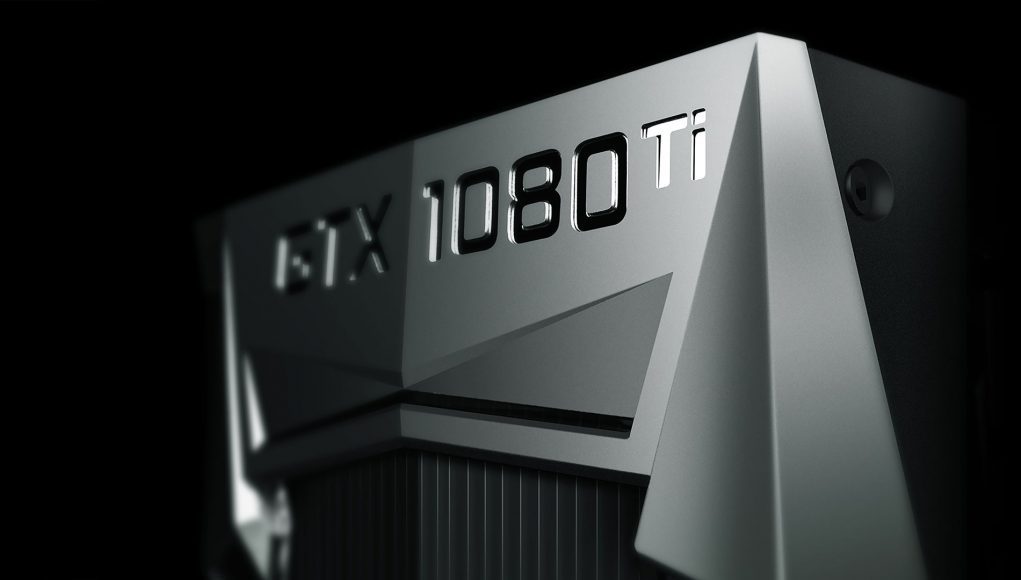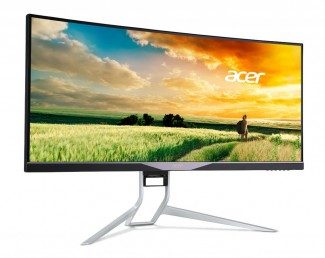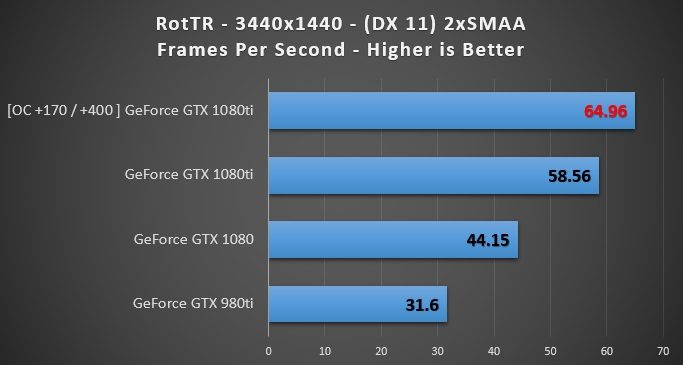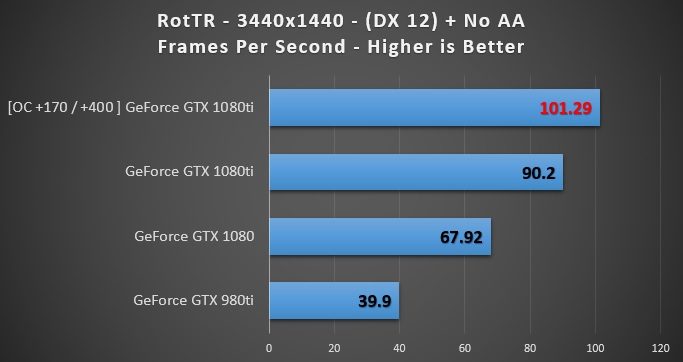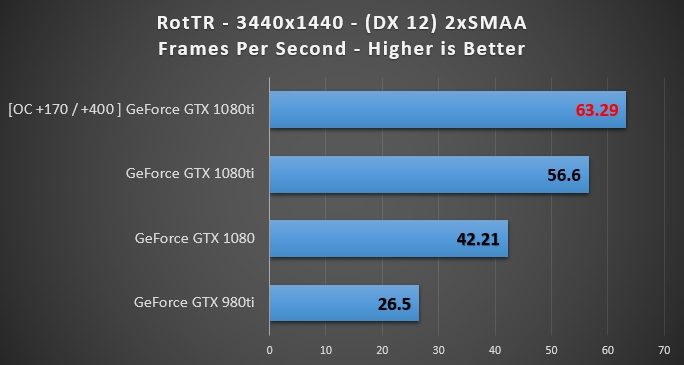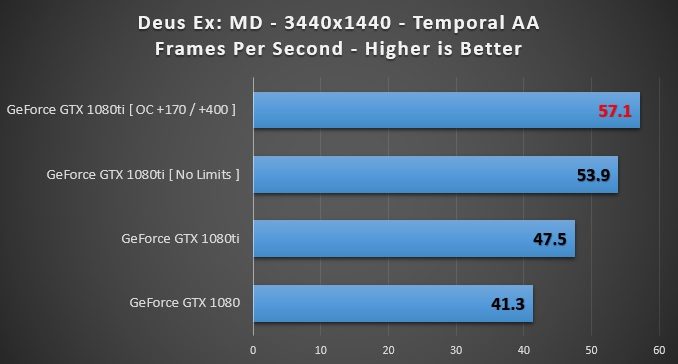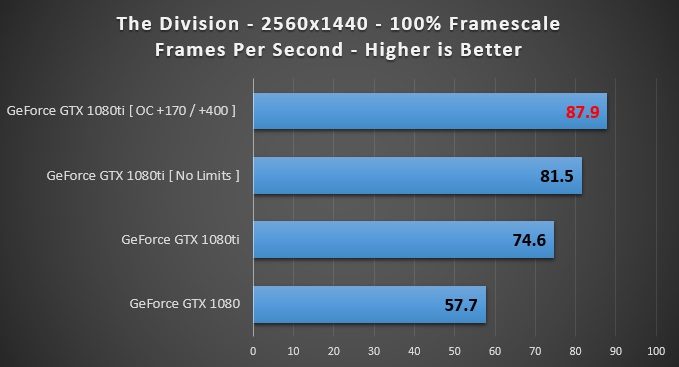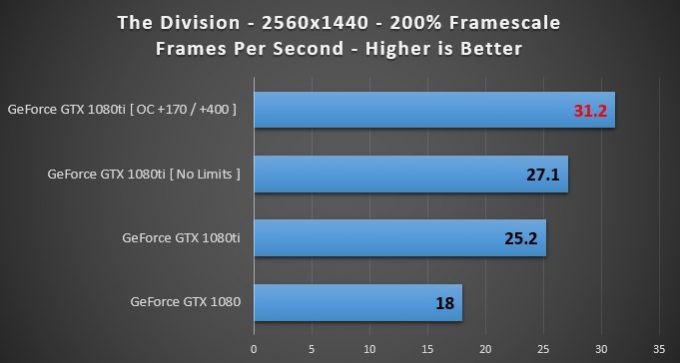Table of Contents
- Introduction
- GTX 1080 Ti Specs
- Testing Methodology & FCAT VR Primer
- Overclocking
- Benchmarks
- Standard Gaming Performance
- Rise of the Tomb Raider (DX11 and DX 12)
- Deus Ex: Mankind Dividied
- The Division
- VR Gaming Performance
- Dirt Rally VR
- Showdown
- Standard Gaming Performance
- Conclusion
Benchmarks
Standard Gaming Performance
Even the most ardent of VR fanatics occasionally takes time out to enjoy the odd standard game or two, so rendering performance in standard monitor-bound titles has to be a big factor in whether the new GTX 1080 Ti represents a worthwhile purchase. Also, our chosen titles represent a real workout for even these top-end GPUs, especially at the 3440×1440 native resolution of Asus’ X34 Predator monitor. How well the GTX 1080 Ti does here gives a good indication of how much raw power the GPU brings to the VR table too.
Rise of the Tomb Raider (DX11 and DX12)
 DirectX 12 is on the rise as far as Windows gaming APIs are concerned (no emails please OpenGL fans!) and games with DX12 support are now common. We chose Rise of the Tomb Raider (2015) as a particularly gorgeous (and demanding) example to include. Every setting is set to its highest available, AA and DX level is noted per-graph.
DirectX 12 is on the rise as far as Windows gaming APIs are concerned (no emails please OpenGL fans!) and games with DX12 support are now common. We chose Rise of the Tomb Raider (2015) as a particularly gorgeous (and demanding) example to include. Every setting is set to its highest available, AA and DX level is noted per-graph.
- Stock clocks, power and heat limits
- Power limits @120% | Heat limits raised to 90 deg. Fan speed manually set to 80%
- Overclocked +170Mhz Core / +400Mhz. Fan speed manually set to 80%.
These benchmarks not only indicate the significant uptick in performance headroom versus last year’s GTX 1080, it also provides existing 980Ti owners a tantalising view at the gains they could enjoy upon upgrading – up to double the performance even before overclocking in fact.
Deus Ex: Mankind Divided
 The second title in the ‘next generation’ offspring of the first person RPG classic, Deus Ex: Mankind Divided (2016) is a curious technical offering. Its dense, baroque futurescapes are rendered with volumetric lighting and and an impressively effective implementation of temporal anti-aliasing and at higher resolutions push even the most powerful PC hardware.
The second title in the ‘next generation’ offspring of the first person RPG classic, Deus Ex: Mankind Divided (2016) is a curious technical offering. Its dense, baroque futurescapes are rendered with volumetric lighting and and an impressively effective implementation of temporal anti-aliasing and at higher resolutions push even the most powerful PC hardware.
- Stock clocks, power and heat limits
- “No Limits” aka Power limits @120% | Heat limits raised to 90 deg. Fan speed manually set to 80%
- Overclocked +170Mhz Core / +400Mhz. Fan speed manually set to 80%
Deus Ex: MD has been a demanding game to run since launch, and even an overclocked 1080ti doesn’t manage this resolution and temporal AA at 60FPS. Included here are figures which highlight that, even if you don’t overclock the Ti’s core or RAM, just unlocking the temp and power limits gives you a significant boost in performance – a nice option for the nervous (or sensible).
The Division
 Ubisoft’s massively multiplayer online third-person shooter, The Division (2016), presents a haunting yet stunning vision of a near-future New York in the aftermath of a viral outbreak. What the game lacks in narrative flair it makes up for in visual fidelity and atmospheric production design. Despite being over a year old, The Division still presents a challenge for hardware when all eye candy is engaged, especially at high resolutions and supersampling levels.
Ubisoft’s massively multiplayer online third-person shooter, The Division (2016), presents a haunting yet stunning vision of a near-future New York in the aftermath of a viral outbreak. What the game lacks in narrative flair it makes up for in visual fidelity and atmospheric production design. Despite being over a year old, The Division still presents a challenge for hardware when all eye candy is engaged, especially at high resolutions and supersampling levels.
The Division sports an in-game benchmark, but it’s unfortunately hobbled at 16:9 only aspect ratios, which means we were only able to test this monitor’s maximum vertical resolution of 1440p. That’s not a resolution which these cards will sweat over, so we decided to run a set of tests at 1:1 pixel scale (a vanilla experience) and another run using the game’s 200% pixel scale setting, an effective x2 supersample (or 4x the pixels per frame). The visual results are stunning as fine detail is resolved at greater distances and the image is rendered with extreme stability and barely a hint of jaggies. All settings were run at the in-game ‘Ultra’ preset. The results below show results for the following:
- Stock clocks, power and heat limits
- Power limits @120% | Heat limits raised to 90 deg. Fan speed manually set to 80%
- Overclocked +170Mhz Core / +400Mhz. Fan speed manually set to 80%
The expected gains can be seen when supersampling is not in force above, and again those performance bumps from unlocking power and temp limits are obvious. Visually speaking, running this game in 2x supersampled mode delivers a stunning image and an overclocked Ti will glean playable (if not ideal) framerates here, one to try if you happen to own a G-Sync monitor perhaps.

